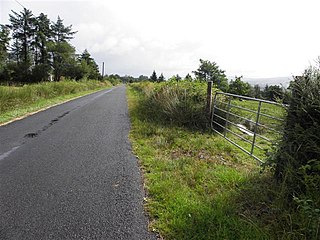
Coppanaghbane, an Anglicisation of the Gaelic ‘Copanach Bán’ meaning The White Place covered with Dock-leaves, is a townland in the civil parish of Templeport, County Cavan, Ireland. It lies in the Roman Catholic parish of Glangevlin and barony of Tullyhaw.
Coppanaghmore, an Anglicisation of the Gaelic ‘Copanach Mór’ meaning The Big Place covered with Dock-leaves, is a townland in the civil parish of Templeport, County Cavan, Ireland. It lies in the Roman Catholic parish of Glangevlin and barony of Tullyhaw.
Corracleigh, an Anglicisation of the Gaelic, ‘Corr na Cloiche’ meaning The Round Hill of the Stone, is a townland in the civil parish of Templeport, County Cavan, Ireland. It lies in the Roman Catholic parish of Glangevlin and barony of Tullyhaw. The local pronunciation is Curracliff.

Derrynananta Lower, an Anglicisation of the Gaelic, ‘Doire na Neannta Íochtar’, meaning The Lower Oak-wood of the Nettles, is a townland in the civil parish of Templeport, County Cavan, Ireland. It lies in the Roman Catholic parish of Glangevlin and barony of Tullyhaw.

Derrynananta Upper, an Anglicisation of the Gaelic, ‘Doire na Neannta Uachtarach’, meaning The Upper Oak-wood of the Nettles, is a townland in the civil parish of Templeport, County Cavan, Ireland. The townland lies in the Roman Catholic parish of Glangevlin and barony of Tullyhaw. In the 19th century, it was also known as Derrynananta Lodge, after a shooting-lodge there called Glengavlen Lodge, which was owned by John Cole, 2nd Earl of Enniskillen.

Derrynatuan, an Anglicisation of the Gaelic, either ‘Doirín an tSuain’, meaning The Little Oak-wood of the Rest or Sleep, or ‘Doire na Tóin’, meaning The Oak-wood of the Low Lying Land, or ‘Doire na Tamhan’, meaning The Oak-wood of the Tree-Stumps, is a townland in the civil parish of Templeport, County Cavan, Ireland. It lies in the Roman Catholic parish of Glangevlin and barony of Tullyhaw.

Drumhurrin, an Anglicisation of the Gaelic ‘Droim Shoirn’, meaning The Hill-Ridge of the Lime-Kiln or Furnace, is a townland in the civil parish of Templeport, County Cavan, Ireland. It lies in the Roman Catholic parish of Glangevlin and barony of Tullyhaw.
Knockgorm, an Anglicisation of the Gaelic 'Cnoc Gorm', meaning The Blue Hill, is a townland in the civil parish of Templeport, County Cavan, Ireland. It lies in the Roman Catholic parish of Glangevlin and barony of Tullyhaw.
Legatraghta, an Anglicisation of the Gaelic ‘Lag an tSneachta’, meaning The Hollow of the Snow, is a townland in the civil parish of Templeport, County Cavan, Ireland. It lies in the Roman Catholic parish of Glangevlin and barony of Tullyhaw.
Tullycrafton, an Anglicisation of the Gaelic, ‘Tulaigh Crofton’ meaning The Hill of the Crofton Family, is a townland in the civil parish of Kinawley, County Cavan, Ireland. It lies in the Roman Catholic parish of Glangevlin and barony of Tullyhaw.

Tullyminister, an Anglicisation of the Gaelic, ‘Tulaigh an Mhinistir’ meaning The Hill of the Parson, is a townland in the civil parish of Templeport, County Cavan, Ireland. It lies in the Roman Catholic parish of Glangevlin and barony of Tullyhaw.

Sralahan is a townland in the civil parish of Kinawley, barony of Tullyhaw, County Cavan, Ireland.

Knockroe is a townland in the civil parish of Kinawley, barony of Tullyhaw, County Cavan, Ireland.

Gorteennaglogh is a townland in the civil parish of Kinawley, barony of Tullyhaw, County Cavan, Ireland.

Gubrimmaddera is a townland in the civil parish of Kinawley, barony of Tullyhaw, County Cavan, Ireland.

Drumcask is a townland in the civil parish of Kinawley, barony of Tullyhaw, County Cavan, Ireland. It is close to the site of a medieval church in Killaghaduff townland, which might explain the meaning of the name.

Derryrealt is a townland in the civil parish of Kinawley, barony of Tullyhaw, County Cavan, Ireland.

Cornalon is a townland in the civil parish of Kinawley, barony of Tullyhaw, County Cavan, Ireland.

Drumboory is a townland in the civil parish of Kinawley, barony of Tullyhaw, County Cavan, Ireland.
Gortnaderrylea is a townland in the civil parish of Kinawley, barony of Tullyhaw, County Cavan, Ireland.















